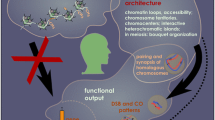Summary
Rumex acetosa (sorrel) is a dioecious plant with a XX/XY1Y2 sex chromosome system. Both the Y chromosomes are nearly entirely heterochromatic and it has been hypothesised that they can persist as chromocenters in male interphase nuclei. Using specific antibodies against 5-methylcytosine and histone H4 acetylated at terminal lysine 5, global levels of DNA methylation and histone acetylation were studied on the sex chromosomes and autosomes of both sexes. The heterochromatic Y chromosomes did not display a higher methylation level compared to the autosomes. The only prominent hypermethylation signals were found at two nucleolar organising regions located on the autosome pair V, as confirmed by in situ hybridisation with 25S rDNA probe and staining. Immunoanalysis of DNA methylation on female and male interphase nuclei neither revealed any sex-specific differences. Two active (silverpositive) nucleoli and two likely inactive nucleolar organising regions (displaying prominent methylation signals) were found in both sexes. In a fraction of nuclei isolated from leaf cells, two peripheral bodies strongly positive for 4′,6-diamidino-2-phenylindole were observed only in males, never in females. These heterochromatin regions were depleted in histone H4 acetylation at terminal lysine 5 and corresponded, according to in situ hybridisation with a Y-chromosome-specific repetitive probe, to the two Y chromosomes. We conclude that the peripheral condensed bodies observed exclusively in male nuclei represent the constitutive heterochromatin of the Y chromosomes which is characterised by a substantial histone H4 underacetylation.
Similar content being viewed by others
References
Ainsworth CC, Lu J, Winfield M, Parker JS (1999) Sex determination by X:autosome dosage:Rumex acetosa (sorrel). In: Ainsworth CC (ed) Sex determination in plants. Bios Scientific Publishers, Oxford, pp 121–136
Amado L, Abranches R, Neves N, Viegas W (1997) Developmentdependent inheritance of 5-azacytidine-induced epimutations in triticale: analysis of rDNA expression patterns. Chromosome Res 5: 445–450
Bennett MD, Smith JB (1991) Nuclear DNA amounts in angiosperms. Philos Trans R Soc Lond B 334: 309–345
Buzek J, Riha K, Siroky J, Ebert I, Greilhuber J, Vyskot B (1998) Histone H4 underacetylation in plant facultative heterochromatin. Biol Chem 379: 1235–1241
Ceccarelli M, Morosi L, Cionini PG (1998) Chromocenter association in plant cell nuclei: determinants, functional significance, and evolutionary implications. Genome 41: 96–103
Charlesworth D, Guttman DS (1999) The evolution of dioecy and plant sex chromosome systems. In: Ainsworth CC (ed) Sex determination in plants. Bios Scientific Publishers, Oxford, pp 25–49
Chen ZJ, Pikaard CS (1997) Epigenetic silencing of RNA polymerase I transcription: a role for DNA methylation and histone modification in nucleolar dominance. Genes Dev 11: 2124–2136
Grant S, Houben A, Vyskot B, Siroky J, Pan WH, Macas J, Saedler H (1994) Genetics of sex determination in flowering plants. Dev Biol 15: 214–230
Hladilova R, Siroky J, Vyskot B (1998) A cytospin technique for the spreading of plant metaphases suitable for immunofluorescence studies. Biotech Histochem 73: 150–156
Houben A, Belyaev ND, Turner BM, Schubert I (1996) Differential immunostaining of plant chromosomes by antibodies recognising acetylated histone H4 variants. Chromosome Res 4: 191–194
Jasencakova Z, Meister A, Walter J, Turner BM, Schubert I (2000) Histone H4 acetylation of euchromatin and heterochromatin is cell cycle dependent and correlated with replication rather than with transcription. Plant Cell 12: 2087–2100
Jeppesen P, Turner BM (1993) The inactive X chromosome in female mammals is distinguished by a lack of histone H4 acetylation, a cytogenetic marker for gene expression. Cell 74: 281–289
Kiss T, Kis M, Solomosy F (1989) Nucleotide sequence of a 25S-rRNA gene from tomato. Nucleic Acids Res 17: 7179
Kuroki Y (1976) Studies on the karyotypes ofRumex acetosa. Mem Ehime Univ 8: 8–85
Mittwoch U (1974) Sex chromatin bodies. In: Yunis JJ (ed) Human chromosome methodology. Academic Press, New York, pp 73–93
Ng HH, Bird A (1999) DNA methylation and chromatin modification. Curr Opin Genet Dev 9: 158–163
Oakeley EJ, Podesta A, Jost JP (1997) Developmental changes in DNA methylation of the two tobacco pollen nuclei during maturation. Proc Natl Acad Sci USA 94: 11721–11725
Pazourkova Z (1964) Sex chromatin inRumex acetosa L. Preslia 36: 422–424
Podesta A, Ruffini Castiglione M, Avanzi S, Montagnoli G (1993) Molecular geometry of antigen binding by a monoclonal antibody against 5-methylcytidine. Int J Biochem 25: 929–933
Ruiz Rejon C, Jamilena M, Garrido Ramos M, Parker JS, Ruiz Rejon M (1994) Cytogenetic and molecular analysis of the multiple sex chromosome system ofRumex acetosa. Heredity 72: 209–215
Shibata F, Hizume M, Kuroki Y (1999) Chromosome painting of Y-chromosomes and isolation of Y-chromosome-specific repetitive sequence in the dioecious plantRumex acetosa. Chromosoma 108: 266–270
— — — (2000) Differentiation and the polymorphic nature of the Y chromosomes revealed by repetitive sequences in the dioecious plant,Rumex acetosa. Chromosome Res 8: 229–236
Siljak-Yakovlev S, Benmalek S, Cerbah M, Coba de la Pena T, Bounaga N, Brown SC, Sarr A (1996) Chromosomal sex determination and heterochromatin structure in date palm. Sex Plant Reprod 9: 127–132
Turner BM (2000) Histone acetylation and an epigenetic code. BioEssays 22: 836–845
—, Fellows G (1989) Specific antibodies reveal ordered and cell-cycle-related use of histone-H4 acetylation sites in mammalian cells. Eur J Biochem 179: 131–139
Vana V (1972) Studies on the sex chromatin in various tissues of the vegetative organs ofRumex acetosa L. Preslia 44: 100–111
Vyskot B, Siroky J, Hladilova R, Belyaev ND, Turner BM (1999) Euchromatin domains in plant chromosomes as revealed by H4 histone acetylation and early DNA replication. Genome 42: 343–350
Wilby AS, Parker JS (1986) Continuous variation in Y-chromosome structure ofRumex acetosa. Heredity 57: 247–254
Zuk J (1969) Autoradiographic studies inRumex with special reference to sex chromosomes. Chromosomes Today 2: 183–187
Author information
Authors and Affiliations
Rights and permissions
About this article
Cite this article
Lengerova, M., Vyskot, B. Sex chromatin and nucleolar analyses inRumex acetosa L.. Protoplasma 217, 147–153 (2001). https://doi.org/10.1007/BF01283395
Received:
Accepted:
Issue Date:
DOI: https://doi.org/10.1007/BF01283395




